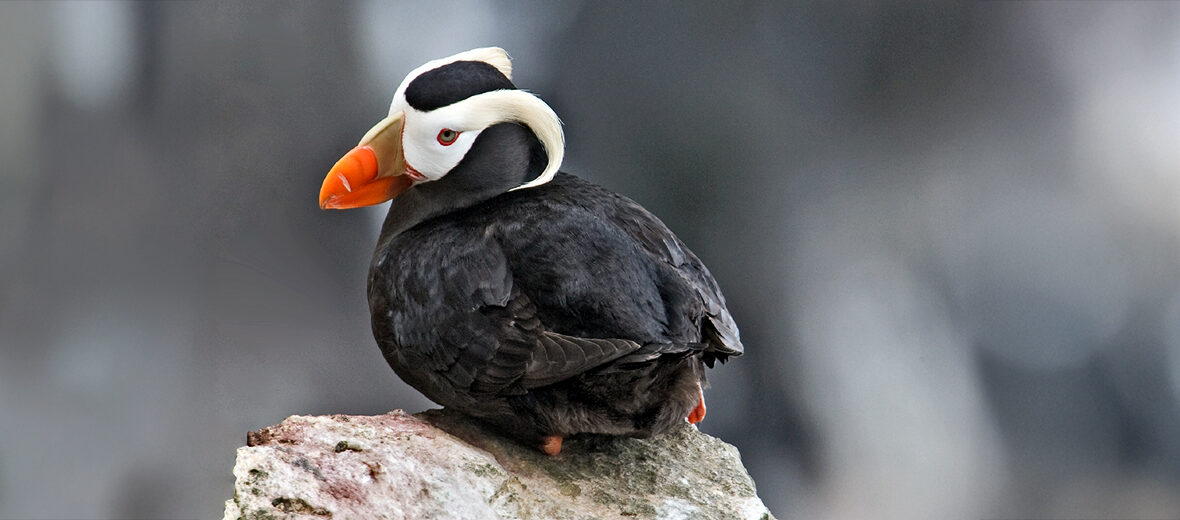
The tufted puffin, aka crested puffin, is a medium-sized pelagic (open water) seabird in the auk family that is found throughout the north Pacific Ocean. They are but 1 of 3 species of puffins. These seabirds face the threats of overfishing; over harvesting; recreational activities that interrupt their breeding grounds; invasive species, that can bring about predation; pollution, in the form of debris and microplastics; and climate change, which brings with it temperature and weather extremes. However, they are abundant enough to be listed as Least Concern by the IUCN. Their population trend is listed as stable.
First the Stats…
Scientific name: Fratercula cirrhata
Weight: Up to 1.6 lbs.
Length: Up to 14 inches
Wingspan: Up to 14 inches
Lifespan: Up to 20+ years
Now on to the Facts!
1.) There are an estimated 5,000,000+/- wild individuals, to date.
2.) Individuals from the western Pacific populations are a little larger than those from the eastern Pacific, and males are usually slightly larger than females.
3.) Their most distinctive feature and subsequent namesake are the yellow tufts that appear each year on both males and females as the summer reproductive season approaches.
4.) Their wings are rather short and adapted for diving, underwater swimming, and capturing prey rather than for gliding, which they are incapable of doing.
5.) As a result, they have thick, dark myoglobin-rich breast muscles adapted for fast and aerobically strong wing-beats, which they can maintain for extended periods of time.
But wait, there’s more on the tufted puffin!
6.) These puffins were first described in 1769 by German zoologist Peter Simon Pallas.
7.) They have been known to nest in small numbers as far south as the northern Channel Islands, off the coast of southern California. That being said, the last confirmed sighting at the Channel Islands happened in 1997. So, it’s been a while.
Did you know…?
Their scientific name Fratercula hails from the Medieval Latin fratercula, or friar, a reference to the black and white plumage which resembles monastic robes. The specific name of cirrhata is Latin and translates to “curly-headed”, from cirrus, a curl of hair.
8.) Their preferred habitat has steep cliffs with relatively soft soil and grass for the creation of burrows.
9.) During the winter months these puffins spend nearly their entire time at sea.
10.) Their nest is typically a simple burrow dug with the bill and feet, although sometimes a crevice between rocks is utilized instead.
But wait, there’s still more on the tufted puffin!
11.) Courting is exhibited via skypointing (extending their wings horizontally and towards the tail, raising their heads, and emitting a long, continuous whistle), strutting, and billing (rubbing their bills against one another).
12.) Females lay a single egg that hatches in up to 45 days.
Did you know…?
The Aleut and Ainu people of the North Pacific have hunted tufted puffins for food and feathers. Skins were used to make tough parkas, worn feather side in, and the silky tufts were sewn into ornamental work. Presently, harvesting of tufted puffins is illegal or discouraged throughout their range.
13.) Both parents take part in incubating the egg.
14.) Fledglings leave the nest in up to 55 days.
15.) Puffins feed on various small fish, squids, and octopuses.
But wait, there’s still a tad more on the tufted puffin!
16.) Bald eagles, peregrine falcons, snowy owls, and Arctic foxes all prey on these birds.
17.) The Department of Natural Resources (DNR) of Washington State has created aquatic reserves surrounding Smith and Minor Islands. Over 36,000 acres of tidelands and seafloor habitat have been included in the proposed aquatic reserve. These islands not only provide the necessary habitat for many seabirds and marine mammals, but this area also contains the largest kelp beds in all of Puget Sound.
18.) Protection Island, which prohibits boats and people from accessing (and maintains a 200 foot barrier) contains 1 of the last 2 nesting colonies of puffins in Puget Sound. Roughly 70% of the tufted puffin population nests on this island.
Now a Short Tufted Puffin Video!
Be sure to share & comment below! Also, check out the Critter Science YouTube channel. Videos added regularly!

Want to suggest a critter for me to write about? Let me know here.
Some source material acquired from: Wikipedia & IUCN
Photo credit: Alan D. Wilson



